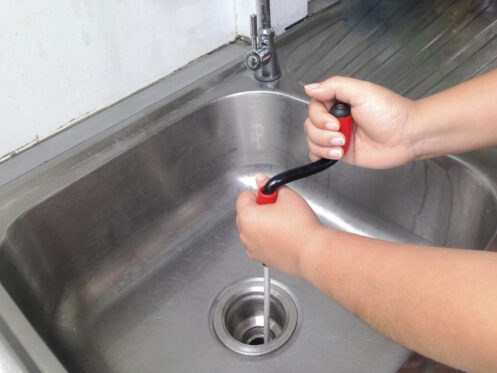Dealing with a clogged toilet is among the least enjoyable tasks you may face at home. It is also a common household problem that, if mishandled, can cause a mess and a ton of inconvenience. Knowing how to tackle a simple clog by yourself can help, but recognizing when to call in a professional is critical for preserving your sanity.
While handling a plunger might seem straightforward, there is a right and a wrong way to go about it. Furthermore, sometimes, your plunger alone just isn’t enough to do the trick. Here are some suggestions for clearing a routine toilet blockage and a few tips for deciding when you should consult a professional plumbing service.
What Causes Toilet Clogs?
Toilet clogs typically stem from too much toilet paper in your plumbing system or, more rarely, from an object that has become lodged in a pipe. A drainage system overwhelmed with paper will block water from exiting your sewer. Likewise, objects that don’t belong in your plumbing system, such as baby wipes, paper towels, and sanitary products, can cause trouble. These items don’t dissolve and will get caught in the bends in pipes, eventually creating a blockage.
Frequently, the clog isn’t just in your toilet. It’s further down the pipe that leads to your main sewer line. Roots intruding into your sewer line or other damage can contribute to widespread plumbing issues. Recognizing the culprit behind a clog may require professional assistance.
How to Prevent Clogs
Preventing toilet clogs begins with mindful flushing. Only human waste and toilet paper should go down your toilet. Everything else belongs in the trash. Even products labeled as “flushable” can still obstruct your pipes. Additionally, using less toilet paper or opting for a thinner variety can make a significant difference in preventing clogs.
You should also check for leaks or slow drains around the house, as these can be early signs of plumbing problems that may lead to a clogged toilet. In addition, regularly inspecting and maintaining your toilet’s internal mechanisms, such as the flapper and fill valve, ensures everything functions as it should while minimizing the likelihood of a future clog.
Tips for Unclogging a Toilet
When approaching a clogged toilet, there are several tried-and-true methods for tackling the blockage on your own. Knowing how to leverage your plunger can make all the difference. For a less conventional approach, household items like hot water and dish soap or baking soda and vinegar can eliminate the blockage. More persistent problems may require a closet auger. Severe clogs that don’t clear could indicate a deeper issue that demands professional insight and equipment.
Using a Plunger
Start with a basic flange plunger made specifically for toilets. Set it in your bowl, ensuring the flange is inside the drain, and the bell covers it entirely for a tight seal. You may have to add water until the water level is halfway up the head of the plunger. With firm, steady pressure, push down and pull up without breaking the seal, creating suction to dislodge the clog.
It may take several attempts, but the clog should clear if it’s minor. Avoid excessive force that can cause splashing or damage to your toilet. If successful, you’ll notice the water in your toilet bowl start to drain.
Hot Water and Dish Soap
Pour a generous amount of dish soap into the toilet bowl. The soap will act as a lubricant to dislodge the blockage. Next, add a gallon of very hot, but not boiling, water to the bowl.
The heat helps break down the materials causing the blockage, while the soap’s slippery properties allow the buildup to pass through the pipes. Let it sit for 15 minutes, and then try flushing. The mixture of soap and hot water may clear the clog.
Baking Soda and Vinegar
To unclog your toilet without harsh chemicals, try baking soda and vinegar. Start by slowly pouring a cup of baking soda into the bowl. Next, add two cups of white vinegar. The resulting chemical reaction can break down the clog. Let it sit for 15-30 minutes before flushing. The reaction of the vinegar and baking soda mixture may dislodge your blockage.
The Closet Auger
A closet auger is a specialized tool for tough clogs. Insert the auger’s end into the toilet bowl, confirming that the curved tip is pointed up. Gradually extend the cable into the drain by cranking the handle clockwise.
When you feel resistance, wiggle the auger. Now, continue cranking to break up the clog. Retract the cable by turning the handle counterclockwise. Always wear gloves for hygiene and hand protection from the metal cable. Flush the toilet to test if the blockage has cleared, repeating this process as necessary.
When to Stop and Call a Professional
There comes a point when the plunger, hot water, or even the closet auger can’t solve your problem. Continual futile attempts at dislodging a clog can be frustrating, and these efforts can even worsen your predicament or damage your pipes.
In addition, if water backs up in your sinks or tubs after you flush or if you spot signs of a leak, it’s time to halt your efforts at DIY plumbing. At this point, you need a professional to assess if the issue is deeper in your plumbing system.
A severe clog may present itself through persistent water backups, strange gurgling sounds from the plumbing, or water rising in the shower or sink when the toilet flushes. Most home remedies usually can’t tackle these blockages.
Attempting to do so without the right tools or plumbing knowledge can cause pipe damage. It could also send your clog deeper into the plumbing, resulting in costly repairs and further disruptions to your plumbing system.
Risks of Not Contacting a Plumber
An unresolved clog can cause continuous water pressure buildup in your pipes. The consequences of this happening are often severe.
This pressure could create leaks or even burst pipes, leaving you with water damage to your home’s structure and potential mold growth. Both problems are expensive to fix and hazardous to mitigate. Additionally, sewage backup poses health risks by contaminating your living spaces with bacteria and waste.
Beyond the immediate damage, neglected clogs can reduce the lifespan of your plumbing infrastructure over time, inviting more severe problems down the road. A swift response from a professional will resolve your immediate issue while preventing future complications.
Choosing the Right Plumbing Service for Your Clog
After an unsuccessful attempt to clear a severe toilet clog, you’ll want to consult a licensed and insured plumbing professional with a proven track record. Such qualifications ensure reliable and accountable service for your home. While knowing how to manage minor clogs yourself is beneficial, recognizing the limits of DIY fixes will prevent you from incurring expensive property damage.
You can turn to our expert at We Care Plumbing, Heating, & Air for stubborn bathroom clogs at your Temecula residence. We can also handle your toughest HVAC and indoor air quality challenges. Contact us today to get help from one of our experienced team members.






